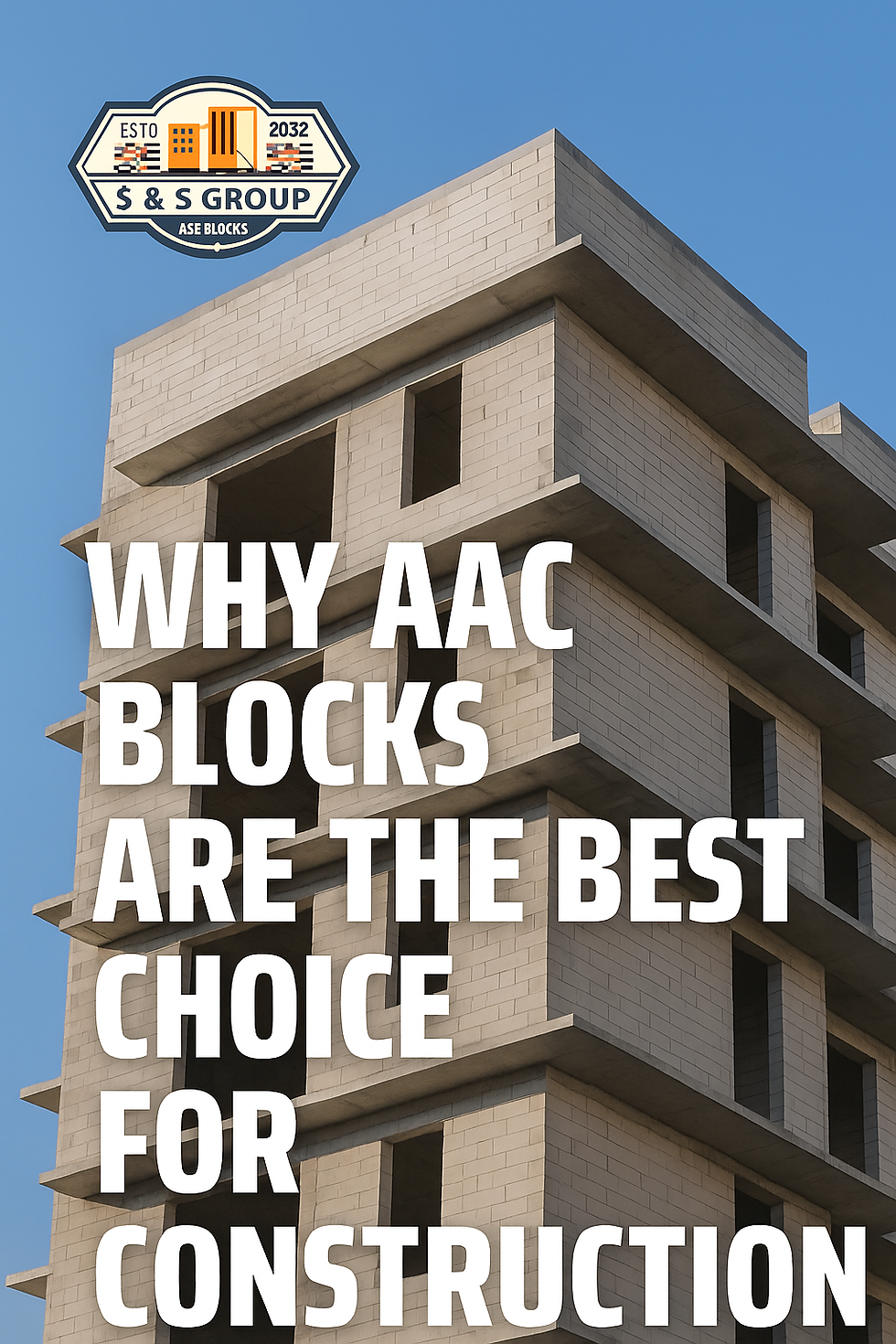AAC Block Size: Advantages & Disadvantages
- ssgroupjabalpur
- Aug 26
- 4 min read
AAC Block Size: Advantages & Disadvantages
The demand for eco-friendly construction materials is steadily increasing in India, as homebuyers and builders look for sustainable and cost-efficient alternatives to conventional bricks. Among these, Autoclaved Aerated Concrete (AAC) blocks are gaining wide recognition for their strength, durability, and environmental benefits.
By choosing AAC blocks for your dream home, you not only reduce construction costs but also contribute to environmental conservation. Below, we explain what AAC blocks are, their features, pricing, advantages, disadvantages, and comparisons with traditional bricks and other alternatives.
What is the Full Form of AAC Block?
AAC stands for Autoclaved Aerated Concrete. These blocks are lightweight, precast building materials known for being environmentally friendly and sustainable.
What are AAC Blocks?
AAC blocks are manufactured using quartz sand, lime, cement, calcined gypsum, water, and aluminum powder. The mixture is aerated and cured under heat and pressure in an autoclave. This process gives AAC blocks their unique properties: lightweight, high strength, and thermal insulation.
They are widely used in both exterior and interior walls and can be finished with stucco, veneers, or siding materials.
Features of AAC Blocks
Color: Greyish-white
Weight: 50% lighter than traditional red bricks
Fire Resistance: 2–6 hours (depending on thickness)
Thermal Efficiency: 3x higher than clay bricks
Energy Savings: Up to 25% reduction in air-conditioning costs
Water Absorption: Around 10% of block weight
Sound Insulation: Approx. 42 dB
Cost-Effective: Nearly one-third cheaper than regular bricks
AAC Block Sizes and Prices
AAC blocks are available in a range of sizes. Prices typically range between ₹2,000 – ₹3,500 per cubic meter, depending on the manufacturer and size.
Common Sizes (Length × Height × Thickness):
600 × 200 × 50 mm
600 × 200 × 75 mm
600 × 200 × 100 mm
600 × 200 × 150 mm
600 × 200 × 200 mm
600 × 200 × 230 mm
600 × 200 × 250 mm
600 × 200 × 300 mm
Arrangement & Shapes of AAC Blocks
Arrangement: Similar to conventional masonry but uses thin-layer mortar. Large panels may require cranes for placement.
Shapes Available:
Lintel (U-shaped) Blocks – Used for beams
Tongue-and-Groove Blocks – Join without mortar at vertical edges
Cored Blocks – For vertical reinforced grout cells
Advantages of AAC Blocks
Lightweight & Faster Construction
50% lighter and 10x larger than red bricks
Easier to handle, cut, and transport
Reduces construction time and labor cost
Earthquake-Resistant
Strong yet light, reducing dead load on structures
Better performance under seismic loads
Thermal Insulation & Energy Efficiency
Air pockets in AAC provide natural insulation
Lowers air-conditioning needs by ~25%
Fire Resistance
Non-combustible, withstands up to 1,200°C for 6 hours
Eco-Friendly & Sustainable
Made from non-toxic raw materials
Generates minimal waste; offcuts can be recycled
High Compressive Strength
Average strength of 3–5 N/mm², stronger than bricks of similar density
Pest & Moisture Resistant
Inorganic material prevents termites and rodents
Low water absorption reduces dampness
Soundproofing
Excellent noise reduction (up to 42 dB)
Preferred in hotels, studios, and hospitals
Disadvantages of AAC Blocks
Not Suitable for Foundations: AAC is not used below DPC (Damp Proof Course) level, as RCC columns handle structural loads better.
Higher Cost for Small Projects: Buying a small number of AAC blocks may be more expensive than red bricks. Best suited for large-scale or high-rise projects.
Requires Skilled Installation: Incorrect placement or poor workmanship can lead to cracks. Professional guidance is necessary.
Finishes for AAC Blocks
Stucco-Type Finishes – Polymer plasters for waterproofing
Masonry Veneers – Can be directly adhered or built as cavity walls
Conventional Sidings – Attached mechanically with furring strips
Where Are AAC Blocks Used?
Residential buildings (apartments, houses)
Commercial spaces (offices, hotels, hospitals, schools)
High-rise structures (due to lightweight and strength)
AAC Blocks vs Red Bricks
Weight: AAC blocks are 80% lighter
Durability: More resistant to fire, moisture, and pests
Cost: Red bricks cost more in logistics and cement usage
Eco-Friendliness: AAC has minimal environmental impact
AAC Blocks vs CLC Blocks
CLC (Cellular Lightweight Concrete): Cheaper but weaker
AAC: Higher compressive strength, better thermal insulation, and durability
History of AAC Blocks
Developed in the 1920s by Dr. Johan Axel Eriksson and Prof. Henrik Kreuger in Sweden
Large-scale production began in 1929
Originally made with alum shale (later banned due to radon emissions)
Modern AAC uses lime, cement, gypsum, and aluminum powder
Now produced globally, with growing demand in India
FAQs
1. Why do AAC blocks develop cracks?
Poor arrangement, shifts in structural beams, water content changes, or temperature variations.
2. Do AAC blocks need plastering?
Internal plastering is usually not required (smooth surface), but external plastering is recommended.
3. Are AAC blocks better than bricks?
Yes. They are stronger, lighter, eco-friendly, and more cost-effective in the long run.
4. How to repair cracks in AAC block walls?
Use specially designed crack-filling mortar.
5. How many bricks equal one AAC block?
One AAC block of size 600 × 200 × 100 mm = approximately 6 red bricks.
✅ Conclusion:AAC blocks are a modern, sustainable, and cost-effective alternative to red bricks. With benefits like faster construction, energy savings, fire resistance, and eco-friendliness, they are best suited for large-scale residential and commercial projects. However, for small load-bearing structures, traditional bricks may still be more economical.
.png)







Comments